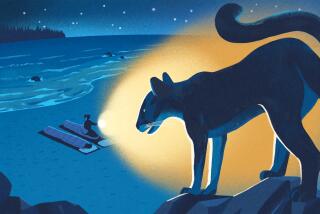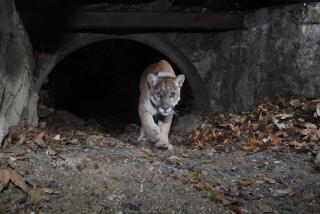Tigers, Tuskers and Rhinos--Oh My!--on a Subtropical Safari in Nepal
- Share via
ROYAL CHITWAN NATIONAL PARK, Nepal — The great Indian one-horned rhinoceros looked unlike any I’d ever seen. This one wasn’t in a cage.
The 2-ton beast lumbered from the forest, snapping fallen branches underfoot, halting in our path. My fears were not allayed by our position on the back of a pickup truck. Rhinos have poor vision and are liable to charge anything.
“Shoot it! Shoot it!” I implored Andrea. But as the rhino broke into a trot, Andrea discovered her camera was out of film, and the animal slipped into the trees.
“I didn’t think we’d see one on the way to the hotel,” Andrea said.
Neither did I. But that’s Nepal, a small country with big surprises. After an unforgettable trek through the snowy Himalayas, the tiny kingdom continued to delight us during a three-day wildlife safari over subtropical plains. We had ventured south from Pokhara by bus, truck and riverboat to Royal Chitwan National Park, a 360-square-mile reserve on the Indian border. Besides rhinos, the park is home to leopards, sloth bears, several species of deer, two types of crocodiles and the elusive royal Bengal tiger.
We trashed our budget on this leg of the journey, checking into Temple Tiger, one of several up-market lodges inside the park. The double rate is listed at $400 a night, but like everything in Nepal, this is negotiable. A bit of comparative shopping around Pokhara travel agencies reduced the price to $160, including meals, activities, park entrance fees and ground transportation.
We learned of the lodge from Harald Husum and Lynn Topf--he’s a Norwegian graphic designer, she’s an American nurse practitioner--a couple we met trekking. Our visit to the park happily coincided with theirs, and within a half-hour of our arrival, the four of us were atop two Asian elephants, riding into the jungle.
Harald was the only one among us who’d been on safari before, in Africa, and he found the encounter with wildlife in Nepal more natural. Andrea and I had no expectations, thrilled merely to bounce along on the back of an elephant. Our pahit, or elephant master, guided the animal with verbal commands and nudges behind the ears with his bare feet. The elephant knocked down small trees in its way and stuffed its mouth with grass yanked from the ground with its trunk. The slow rise-and-fall motion produced by the hulking mammal’s gait evoked riding a bucking bronco across the bottom of a swimming pool.
My earlier concern over the missed photo opportunity was needless, as rhinos were everywhere we looked. Our pahit took glee in maneuvering the elephant close to the armored creatures, causing them to snort and stomp. As we gave chase, barking deer--animals the size of Labrador retrievers--scampered through the undergrowth.
Most visitors to Chitwan hope to glimpse a tiger, but few do. A worker told me he had not seen one the entire season. We spotted evidence of a tiger’s presence--tracks in the sand along the Narayani River, a chewed-up deer leg--but no tiger.
Temple Tiger guests stay in individual elevated bungalows set well apart in the trees. Each unit has an attached bathroom, with solar-heated shower and marble floor inlaid with stone tiger paw prints. The safari decor--woven wicker walls, spears, antlers--prompted Andrea to remark, “It’s very Ralph Lauren.”
Our private balcony offered an idyllic place to enjoy the hoots and hollers of the park’s 525 species of birds--had there been any time to use it. The neatly pressed staff kept us hopping dawn to dusk with river trips, nature walks and slide shows. A highlight was our encounter with an entertaining band of gray langur monkeys. The screeching primates leaped from tree to tree, grabbing branches that broke their falls like bungee cords.
We ate meals on bronze plates in an elegantly rustic, screened dining house, complete with sunken fireplace. Some of the food was familiar (onion quiche), some not (water buffalo), all of it delicious. After every few bites, a team of Nehru-jacketed waiters rushed in to scoop more food onto our platters.
The tea and coffee delivered to our deck at 5:30 the next morning served as a wake-up call for the sunrise safari. We were a full group, so Harald, Lynn, Andrea and I shared an elephant, each taking a corner of the howdah, the wooden-railed, padded riding platform. The jungle was bathed in an orange glow, dewy grass and spider webs glistening in the early light.
I marveled at how the mass of gray beneath us managed to glide through the bush in near silence, but after 90 minutes we had sighted nothing more than two rhinos. When our elephant turned for home, blazing a different trail from the others, I figured we were ending an uneventful, albeit pleasant, ride.
At last something new appeared. A large spotted deer now stood frozen in the tall grass to our left. It eyed us nervously as the elephant abruptly stopped.
“Tiger,” the pahit whispered, making me think he did not know the English word for the animal we observed. Goose bumps sprang from my flesh when I realized he was looking elsewhere. And I felt my heart in my throat when I swiveled my head and took in the giant striped cat lurking about 100 feet in front of us.
“Oh, my God!” I blurted.
“Oh! Oh! Oh!” gasped Lynn, pounding on the pahit’s shoulders.
The tiger was beautiful but scowling, perhaps miffed that we had come between it and breakfast. I did not blink, afraid it might approach or, worse, vanish. But like magic, the magnificent cat melted into the forest.
The pahit checked his watch and aimed the elephant toward the lodge. For some of us in the jungle, breakfast was waiting.
NEXT WEEK: A whirlwind journey through Thailand, Cambodia.
*
Did you miss a Wander Year installment? The entire series since it began in January can be found on The Times’ Web site at https://www.latimes.com/travel/wander.
More to Read
Sign up for Essential California
The most important California stories and recommendations in your inbox every morning.
You may occasionally receive promotional content from the Los Angeles Times.













